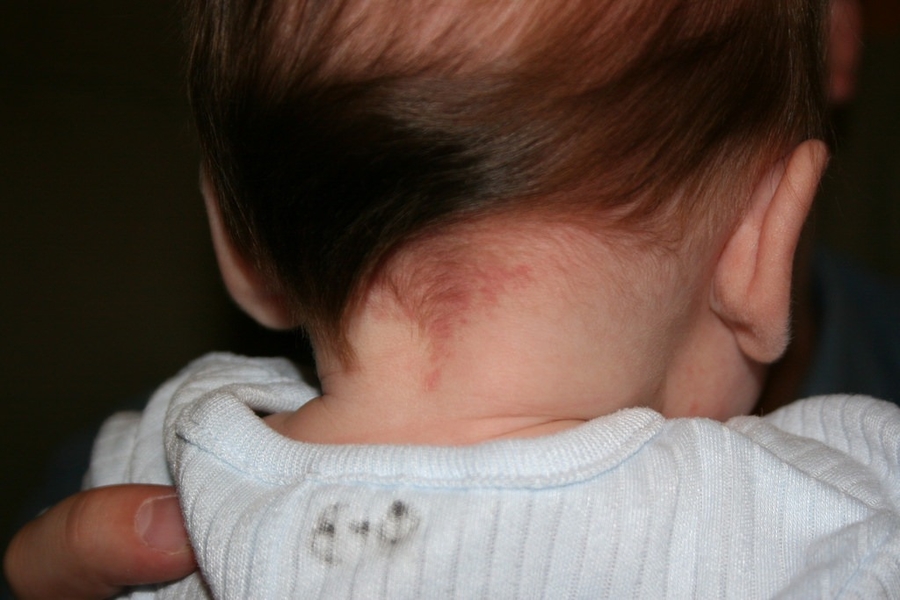
Different Types of Birthmarks
27 Dec 2017 | 4 min Read
Babychakra
Author | 1369 Articles
On or under our skin, birthmarks come in various forms, colors, textures, and sizes. They can arise at birth or within the first year or two of life, and more than 10% of infants have birthmarks on their skin. Learn more about birthmarks, different types of birthmarks, and their treatment in detail.
Birthmarks: What Are They?
A birthmark can be a little spot that adds a touch of beauty and uniqueness to your little one’s face. Some birthmarks may be downright ugly. Birthmarks are nothing but patches of color or marks on babies’ skin that are present right at birth or appear shortly after. They generally grow in size for up to a year, after which they start to lighten or fade. They vary in size, shape and color. Most birthmarks are flat, but there are also other types of birthmarks and raised birthmarks.
What Causes A Birthmark?
Blood vessels do not develop properly, and thus it further develops vascular birthmarks. There are either too many or broader than normal. An expansion of the cells that produce pigment (colour) in the skin leads to pigmented birthmarks in children.
Are Birthmarks Genetic?
Some birthmarks are hereditary and pass down through generations. However, the majority are not. Gene mutations are responsible for a small percentage of cases. Klippel-Trenaunay syndrome is an uncommon illness that affects certain newborns born with port-wine stains.
Types Of Birthmarks
Some of the common types of birthmarks are as follows:
- Mongolian Spots: These are types of brown birthmarks that appear on darker-skinned babies. They are blackish-blue in color and are found on the lower back and buttocks of children. They are a result of excess pigmentation and tend to fade over time.
- Black or Blue Moles: Moles can come in different sizes and can vary from light brown to almost black in color. Moles tend to become smaller with the growth of the baby but do not completely resolve by themselves. Large moles that tend to itch or bleed should be shown to a doctor.
- Hemangiomas: Also known as strawberry marks, these show up as flat, red spots on the skin. They slowly become raised and deeper red in color. Their growth tends to slow down between 4 to 5 months after which they slowly tend to fade. They tend to leave stretched or wrinkled skin behind, particularly large marks.
- Angel’s Kisses or Stork Bites: These are patches of slightly reddened skin found on the face or back of the head and neck of babies. They are caused by an expansion of the blood vessels near the surface of the skin. Patches on the face tend to fade, while those on the neck may not.
- Port Wine Stains: These marks appear on the face and look like the stain marks of juices. They are purple, red or pink in color, and they tend to grow darker and bigger with age. Port-wine stains near the eyes and head may indicate problems in the brain and vision and should be looked into by a doctor. They are again due to the presence of dilated blood vessels underneath giving them the hint of port wine colour.
Tips For Monitoring Birthmarks: Treatment
Most birthmarks are harmless, and the best course of action is often to do nothing at all. Remember that there are different types of birthmarks and the treatment for them must be as suggested by the doctor. Treatments purely for cosmetic reasons may not work, be painful, or backfire. It is important to realize that you cannot treat some birthmarks.
- Laser: Laser therapy is recommended for birthmarks on the surface of the skin such as Port wine stains.
- Steroids: Doctors may recommend topical steroids or inject medication in the birthmark directly to control its growth or shrink it.
- Surgery: Surgery may be used as a last resort to permanently remove the birthmark if other treatments have failed or if the birthmark is interfering with routine life.
Hope you found this article helpful! Also, do not forget to share your views in the comment section.
Disclaimer: The information in the article is not intended or implied to be a substitute for professional medical advice, diagnosis or treatment. Always seek the advice of your doctor.
Also read: 5 Natural Remedies to Help Heal Skin Issues in Babies
Explore the entire collection of articles: Baby Care
Related Articles:
Infantile Hemangioma: Must know about Infantile Hemangioma and ways to cure it, in detail, here!
Newborn Skincare: Here, we’ve got you answered with various newborn skincare tips which you need to check out right away.
Congenital Birth Defects: Read on to know what are congenital birth defects and its various types in children.
A


Related Topics for you
Suggestions offered by doctors on BabyChakra are of advisory nature i.e., for educational and informational purposes only. Content posted on, created for, or compiled by BabyChakra is not intended or designed to replace your doctor's independent judgment about any symptom, condition, or the appropriateness or risks of a procedure or treatment for a given person.
